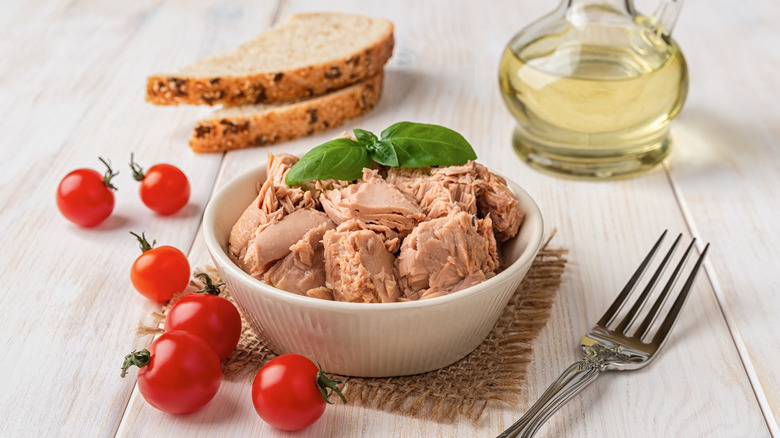The Downsides Of Eating Too Much Tuna
Loaded with protein and healthy fats, tuna is a nutritional powerhouse. Its rich flavor leaves you craving for more, and you don't have to worry about calories. A can of light tuna has roughly 140 calories and over 32 grams of lean protein, per My Food Data. With one can of light tuna, you'll also get 15% of the recommended daily iron intake, 212% of the daily recommended amount of selenium, and large doses of vitamin A, potassium, phosphorus, and vitamin B12. Wild-caught tuna steak is even higher in protein and other key nutrients.
Eating tuna every few days can be a simple, convenient way to increase your protein intake. This nutrient promotes satiety and boosts your metabolism while preserving lean mass. As a result, it can facilitate fat loss and prevent metabolic slowdown, explains a 2012 review published in the British Journal of Nutrition. Tuna also is an excellent source of omega-3s, the "good" fats that support heart and eye health, points out WebMD.
But like with most things, moderation is the key. Eating too much tuna can actually do more harm than good. You still need to practice portion control, diversify your protein sources, and choose quality over quantity.
Can eating too much tuna make you sick?
The FDA recommends eating no more than 2 servings of canned light tuna or 1 serving of either yellowfin or albacore (white) tuna per week. The reason is that most tuna varieties are high in methylmercury, a toxin linked to neurologic and kidney disorders, warns the Centers for Disease Control and Prevention (CDC). Most people have small amounts of this chemical in the bloodstream, but eating too much tuna can result in dangerously high blood mercury levels. Fish with the highest mercury levels include bigeye tuna, tilefish, shark, king mackerel, orange roughly, and swordfish, notes the FDA.
Mercury builds up in animal tissues over time, explains the CDC. Therefore, large fish contains more of this toxin than smaller fish species. The mean mercury level in yellowfin and albacore tuna is around 0.35 parts per million (PPM), according to the FDA. Bigeye tuna, by comparison, has approximately 0.68 PPM of mercury. Canned light tuna is a safer option, but it still has above-average mercury levels (via Mercury and Fish).
This compound accumulates in the blood and may cause toxicity, especially in small children and unborn babies. However, eating too much tuna every now and then is unlikely to make you sick. "One week's consumption of fish does not change the level of methylmercury in the body much at all," says the FDA. The organization also recommends limiting albacore tuna steak to 6 ounces per week because it's higher in mercury than canned varieties.


